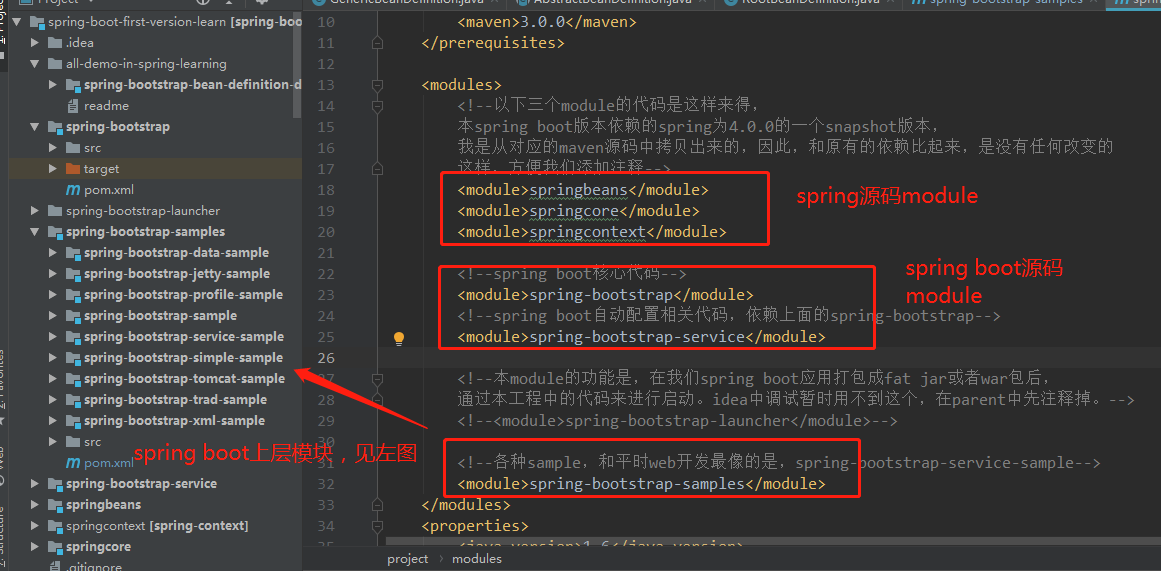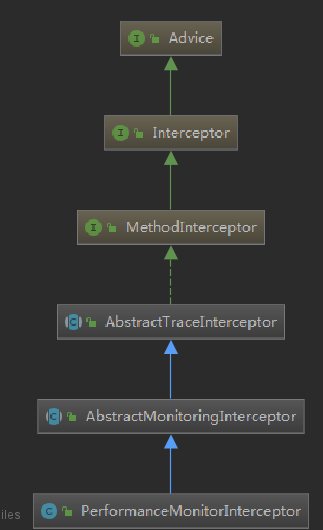曹工说Spring Boot源码(19)-- Spring 带给我们的工具利器,创建代理不用愁(ProxyFactory)
三国梦回 人气:0写在前面的话
相关背景及资源:
曹工说Spring Boot源码(1)-- Bean Definition到底是什么,附spring思维导图分享
曹工说Spring Boot源码(2)-- Bean Definition到底是什么,咱们对着接口,逐个方法讲解
曹工说Spring Boot源码(3)-- 手动注册Bean Definition不比游戏好玩吗,我们来试一下
曹工说Spring Boot源码(4)-- 我是怎么自定义ApplicationContext,从json文件读取bean definition的?
曹工说Spring Boot源码(5)-- 怎么从properties文件读取bean
曹工说Spring Boot源码(6)-- Spring怎么从xml文件里解析bean的
曹工说Spring Boot源码(7)-- Spring解析xml文件,到底从中得到了什么(上)
曹工说Spring Boot源码(8)-- Spring解析xml文件,到底从中得到了什么(util命名空间)
曹工说Spring Boot源码(9)-- Spring解析xml文件,到底从中得到了什么(context命名空间上)
曹工说Spring Boot源码(10)-- Spring解析xml文件,到底从中得到了什么(context:annotation-config 解析)
曹工说Spring Boot源码(11)-- context:component-scan,你真的会用吗(这次来说说它的奇技淫巧)
曹工说Spring Boot源码(12)-- Spring解析xml文件,到底从中得到了什么(context:component-scan完整解析)
曹工说Spring Boot源码(13)-- AspectJ的运行时织入(Load-Time-Weaving),基本内容是讲清楚了(附源码)
曹工说Spring Boot源码(14)-- AspectJ的Load-Time-Weaving的两种实现方式细细讲解,以及怎么和Spring Instrumentation集成
曹工说Spring Boot源码(15)-- Spring从xml文件里到底得到了什么(context:load-time-weaver 完整解析)
曹工说Spring Boot源码(16)-- Spring从xml文件里到底得到了什么(aop:config完整解析【上】)
曹工说Spring Boot源码(17)-- Spring从xml文件里到底得到了什么(aop:config完整解析【中】)
曹工说Spring Boot源码(18)-- Spring AOP源码分析三部曲,终于快讲完了 (aop:config完整解析【下】)
工程代码地址 思维导图地址
工程结构图:

概要
本篇是接着前三篇讲的,但是本篇相对独立,即使不使用spring aop 和spring ioc,我们也可以利用今天要讲的ProxyFactory为我们所用。
曹工说Spring Boot源码(16)-- Spring从xml文件里到底得到了什么(aop:config完整解析【上】)
曹工说Spring Boot源码(17)-- Spring从xml文件里到底得到了什么(aop:config完整解析【中】)
曹工说Spring Boot源码(18)-- Spring AOP源码分析三部曲,终于快讲完了 (aop:config完整解析【下】)
前面几篇说到,spring如何实现aop,即将匹配切点的bean,生成动态代理,并将生成的动态代理放到ioc容器,来替换原先的bean,一系列骚操作,完成"代理换真身"的操作。
jdk动态代理
比较老套的话题,但是,我问大家几个问题,看看大家是否真的足够了解他呢?
在代理对象上,调用不在接口中的方法
package foo;
public class Performer implements Perform {
@Override
public void sing() {
try {
Thread.sleep(1000);
} catch (InterruptedException e) {
e.printStackTrace();
}
System.out.println("男孩在唱歌");
}
public void eat() {
System.out.println("男孩在吃饭");
}
}可以看到,我们sing是实现了接口中的方法,而eat不在接口中定义。
那么,如下代码,结果会是啥:
@Test
public void createJdkDynamicProxyManual() throws NoSuchMethodException, InvocationTargetException, IllegalAccessException {
ClassLoader loader = Thread.currentThread().getContextClassLoader();
Object generatedProxy = Proxy.newProxyInstance(loader, new Class[]{Perform.class}, new InvocationHandler() {
@Override
public Object invoke(Object proxy, Method method, Object[] args) throws Throwable {
System.out.println("proxy:" + proxy.getClass());
return "hahh";
}
});
Method eat = Perform.class.getMethod("eat");
eat.setAccessible(true);
eat.invoke(generatedProxy,null);
}代码中,我们创建了一个代理对象:generatedProxy;然后,调用了其eat方法,结果会是啥呢?
java.lang.NoSuchMethodException: foo.Perform.eat()
at java.lang.Class.getMethod(Class.java:1665)
at java.lang.Class.getMethod(Class.java:1665)为啥会这样呢?因为我们创建代理对象时,是在Perform.class这个接口上创建的。大家可以再仔细看看。
jdk 动态代理(Proxy.newProxyInstance)有哪几个步骤
这个问题,有人思考过吗?简单来说,其实有3个步骤。
- 生成动态代理类的class,虽然不像其他class文件那样,是编译了就有的,这里,是动态生成的;
- 加载第一步拿到的字节流,丢给jvm加载该class,拿到Class对象
- 根据第二步的Class对象,反射生成动态代理对象。
我刚仔细看了Proxy.newProxyInstance的方法注释:
Returns an instance of a proxy class for the specified interfaces that dispatches method invocations to the specified invocation handler. This method is equivalent to: Proxy.getProxyClass(loader, interfaces). // 对应步骤1和2 getConstructor(new Class[] { InvocationHandler.class }). // 对应步骤3 newInstance(new Object[] { handler }); // 对应步骤3
其中,第一步,细问一下,class是怎么生成的,很多人估计又答不上了。咱们这里就看一下:
public static Object newProxyInstance(ClassLoader loader,
Class<?>[] interfaces,
InvocationHandler h)
throws IllegalArgumentException
{
/*
* Look up or generate the designated proxy class.
*/
Class<?> cl = getProxyClass0(loader, interfaces);
/*
* Invoke its constructor with the designated invocation handler.
*/
return newInstance(cons, ih);
}可以看到,主要的获取Class,是getProxyClass0方法,这个方法里面代码不少,去掉非核心的缓存等部分,核心的部分如下:
String proxyName = proxyPkg + "$Proxy" + num;
/*
* Generate the specified proxy class.
*/
byte[] proxyClassFile = ProxyGenerator.generateProxyClass(
proxyName, interfaces);
proxyClass = defineClass0(loader, proxyName,
proxyClassFile, 0, proxyClassFile.length);
这其中,ProxyGenerator.generateProxyClass 负责生成class的字节流,对应我们前面讲到的步骤1;defineClass0对应类加载。我们仔细说说:
字节流生成
这部分呢,其实就是调用了ProxyGenerator.generateProxyClass,我们跟踪发现,它的全名为:sun.misc.ProxyGenerator,是sun包下的。这部分没法看源码,还好我之前下载过openjdk的源码,这里我给大家全文贴一下:
/** * Generate a class file for the proxy class. This method drives the * class file generation process. */ private byte[] generateClassFile() { /* ============================================================ * Step 1: Assemble ProxyMethod objects for all methods to * generate proxy dispatching code for. */ /* * Record that proxy methods are needed for the hashCode, equals, * and toString methods of java.lang.Object. This is done before * the methods from the proxy interfaces so that the methods from * java.lang.Object take precedence over duplicate methods in the * proxy interfaces. */ addProxyMethod(hashCodeMethod, Object.class); addProxyMethod(equalsMethod, Object.class); addProxyMethod(toStringMethod, Object.class); /* * Now record all of the methods from the proxy interfaces, giving * earlier interfaces precedence over later ones with duplicate * methods. */ for (int i = 0; i < interfaces.length; i++) { Method[] methods = interfaces[i].getMethods(); for (int j = 0; j < methods.length; j++) { addProxyMethod(methods[j], interfaces[i]); } } /* * For each set of proxy methods with the same signature, * verify that the methods' return types are compatible. */ for (List<ProxyMethod> sigmethods : proxyMethods.values()) { checkReturnTypes(sigmethods); } /* ============================================================ * Step 2: Assemble FieldInfo and MethodInfo structs for all of * fields and methods in the class we are generating. */ try { methods.add(generateConstructor()); for (List<ProxyMethod> sigmethods : proxyMethods.values()) { for (ProxyMethod pm : sigmethods) { // add static field for method's Method object fields.add(new FieldInfo(pm.methodFieldName, "Ljava/lang/reflect/Method;", ACC_PRIVATE | ACC_STATIC)); // generate code for proxy method and add it methods.add(pm.generateMethod()); } } methods.add(generateStaticInitializer()); } catch (IOException e) { throw new InternalError("unexpected I/O Exception"); } if (methods.size() > 65535) { throw new IllegalArgumentException("method limit exceeded"); } if (fields.size() > 65535) { throw new IllegalArgumentException("field limit exceeded"); } /* ============================================================ * Step 3: Write the final class file. */ /* * Make sure that constant pool indexes are reserved for the * following items before starting to write the final class file. */ cp.getClass(dotToSlash(className)); cp.getClass(superclassName); for (int i = 0; i < interfaces.length; i++) { cp.getClass(dotToSlash(interfaces[i].getName())); } /* * Disallow new constant pool additions beyond this point, since * we are about to write the final constant pool table. */ cp.setReadOnly(); ByteArrayOutputStream bout = new ByteArrayOutputStream(); DataOutputStream dout = new DataOutputStream(bout); try { /* * Write all the items of the "ClassFile" structure. * See JVMS section 4.1. */ // u4 magic; dout.writeInt(0xCAFEBABE); // u2 minor_version; dout.writeShort(CLASSFILE_MINOR_VERSION); // u2 major_version; dout.writeShort(CLASSFILE_MAJOR_VERSION); cp.write(dout); // (write constant pool) // u2 access_flags; dout.writeShort(ACC_PUBLIC | ACC_FINAL | ACC_SUPER); // u2 this_class; dout.writeShort(cp.getClass(dotToSlash(className))); // u2 super_class; dout.writeShort(cp.getClass(superclassName)); // u2 interfaces_count; dout.writeShort(interfaces.length); // u2 interfaces[interfaces_count]; for (int i = 0; i < interfaces.length; i++) { dout.writeShort(cp.getClass( dotToSlash(interfaces[i].getName()))); } // u2 fields_count; dout.writeShort(fields.size()); // field_info fields[fields_count]; for (FieldInfo f : fields) { f.write(dout); } // u2 methods_count; dout.writeShort(methods.size()); // method_info methods[methods_count]; for (MethodInfo m : methods) { m.write(dout); } // u2 attributes_count; dout.writeShort(0); // (no ClassFile attributes for proxy classes) } catch (IOException e) { throw new InternalError("unexpected I/O Exception"); } return bout.toByteArray(); }这里其实是有面试题的,我之前还被问过,问我用的什么技术来生成class字节流,这里其实是没有用任何第三方工具的,这个类的import语句部分,也没有asm、javaasist等工具。
import java.io.ByteArrayOutputStream; import java.io.DataOutputStream; import java.io.FileOutputStream; import java.io.IOException; import java.io.OutputStream; import java.lang.reflect.Array; import java.lang.reflect.Method; import java.util.ArrayList; import java.util.HashMap; import java.util.LinkedList; import java.util.List; import java.util.ListIterator; import java.util.Map; import sun.security.action.GetBooleanAction;加载class字节流为Class
这部分的代码即为前面提到的:
try { proxyClass = defineClass0(loader, proxyName, proxyClassFile, 0, proxyClassFile.length); }其中,defineClass0 是一个native方法:
java.lang.reflect.Proxy#defineClass0 private static native Class defineClass0(ClassLoader loader, String name, byte[] b, int off, int len);让我比较惊讶的是,这个native方法,是在Proxy类里,且除了此处的调用,没有被其他代码调用。
我去看了Classloader这个类的代码,里面也有几个native的defineClass的方法:
private native Class defineClass0(String name, byte[] b, int off, int len, ProtectionDomain pd); private native Class defineClass1(String name, byte[] b, int off, int len, ProtectionDomain pd, String source); private native Class defineClass2(String name, java.nio.ByteBuffer b, int off, int len, ProtectionDomain pd, String source);看来,Proxy是自己自立门户啊,没有使用Classloader类下面的defineClass等方法。
如果大家想看生成的class的文件的内容,可以加这个虚拟机启动参数:
-Dsun.misc.ProxyGenerator.saveGeneratedFiles=true或者main最前面,加这个:
System.getProperties().put("sun.misc.ProxyGenerator.saveGeneratedFiles", "true");反射生成代理对象
这步就没啥好说的了,经过上面第二步,已经拿到Class对象了。反射对于大家,也是轻车熟路了。
Constructor<?> cons = cl.getConstructor({ InvocationHandler.class }); final InvocationHandler ih = h; newInstance(cons, ih); private static Object newInstance(Constructor<?> cons, InvocationHandler h) { return cons.newInstance(new Object[] {h} ); }这里,我们看到,获取的构造函数,就是要接收一个InvocationHandler对象的。拿到了构造函数后,接下来,就调用了构造函数的newInstance,来生成代理对象。
具体的调用就不说了,反正你调用的任何方法(只能调用接口里有的那些),都会转到invocationHandler的invoke方法。
关于jdk动态代理的思考
其实,大家看到上面,会想下面这个问题不?现在在代理对象上,调用方法,最终都会进入到:
java.lang.reflect.InvocationHandler#invoke
public Object invoke(Object proxy, Method method, Object[] args)
throws Throwable;我如果想在这个逻辑里面,去调用原始目标的方法,怎么办呢?
我们看看传给我们的几个参数:
1. proxy,代理对象;这个没办法拿到原始对象
2. method,是被调用的方法,也拿不到原始对象
3. args,给method的参数,也拿不到原始对象。这就迷离了。那我咋办呢?
答案是,在创建InvocationHandler时,把原始对象传进去,以及其他一切必要的信息,都传进去。
当然,你也可以不传进去,在invoke方法里,为所欲为,比如下面的方法:
ClassLoader loader = Thread.currentThread().getContextClassLoader();
Object generatedProxy = Proxy.newProxyInstance(loader, new Class[]{Perform.class}, new InvocationHandler() {
@Override
public Object invoke(Object proxy, Method method, Object[] args) throws Throwable {
System.out.println("到我这为止,不会调用target了");
return null;
}
});
// 这里,虽然调用了sing,但里面的逻辑也不会执行。
((Perform)generatedProxy).sing();其实,这个代理,已经相当于是Perform接口的另一个实现了;和之前的实现类,没有半毛钱关系。
如果要让它实施代理的工作,可以这样做:
@Test
public void createJdkDynamicProxyManual() throws NoSuchMethodException, InvocationTargetException, IllegalAccessException {
Performer performer = new Performer();
MyCustomInvocationHandler myCustomInvocationHandler = new MyCustomInvocationHandler(performer);
ClassLoader loader = Thread.currentThread().getContextClassLoader();
Object generatedProxy = Proxy.newProxyInstance(loader,
new Class[]{Perform.class}, myCustomInvocationHandler);
((Perform)generatedProxy).sing();
}
public static class MyCustomInvocationHandler implements InvocationHandler {
Performer performer;
public MyCustomInvocationHandler(Performer performer) {
this.performer = performer;
}
@Override
public Object invoke(Object proxy, Method method, Object[] args) throws Throwable {
System.out.println("我是一个称职的代理");
return method.invoke(performer,args);
}
}上面这个代码,就没问题了。会输出如下:
我是一个称职的代理
男孩在唱歌
jdk动态代理实现思路的案例代码
我们上面说了怎么样正确地实现代理的思路,就是要把target/原始bean,在new invocationHandler的时候,传递给它,后续在invoke里再使用。我们看看框架对invocationHandler的其他实现,是怎么做的吧?
我在project里找了下InvocationHandler的实现类,发现了jdbc中的一个实现类。
org.springframework.jdbc.datasource.ConnectionProxy
public interface ConnectionProxy extends Connection {
/**
* Return the target Connection of this proxy.
* <p>This will typically be the native driver Connection
* or a wrapper from a connection pool.
* @return the underlying Connection (never {@code null})
*/
Connection getTargetConnection();
}这个是Connection的子接口,通过这个接口,获取真正的数据库连接。我们看看其代理实现:
org.springframework.jdbc.datasource.LazyConnectionDataSourceProxy#getConnection(java.lang.String, java.lang.String)
public Connection getConnection(String username, String password) throws SQLException {
return (Connection) Proxy.newProxyInstance(
ConnectionProxy.class.getClassLoader(),
new Class[] {ConnectionProxy.class},
new LazyConnectionInvocationHandler(username, password));
}这个代理实现,主要是延迟获取数据库连接,等到使用的时候,才去获取连接;而不是启动时,即建立连接池。
private class LazyConnectionInvocationHandler implements InvocationHandler {
private String username;
private String password;
private Boolean readOnly = Boolean.FALSE;
private Integer transactionIsolation;
private Boolean autoCommit;
private boolean closed = false;
private Connection target;
public LazyConnectionInvocationHandler() {
this.autoCommit = defaultAutoCommit();
this.transactionIsolation = defaultTransactionIsolation();
}
public LazyConnectionInvocationHandler(String username, String password) {
this();
this.username = username;
this.password = password;
}
public Object invoke(Object proxy, Method method, Object[] args) throws Throwable {
// Invocation on ConnectionProxy interface coming in...
if (method.getName().equals("equals")) {
// We must avoid fetching a target Connection for "equals".
// Only consider equal when proxies are identical.
return (proxy == args[0]);
}
...
else if (method.getName().equals("getTargetConnection")) {
// Handle getTargetConnection method: return underlying connection.
return getTargetConnection(method);
}
...
}
这里呢,如果方法为getTargetConnection,则调用了以下方法:
private Connection getTargetConnection(Method operation) throws SQLException {
if (this.target == null) {
// No target Connection held -> fetch one.
if (logger.isDebugEnabled()) {
logger.debug("Connecting to database for operation '" + operation.getName() + "'");
}
// 通过用户名,密码去获取数据库连接
this.target = (this.username != null) ?
getTargetDataSource().getConnection(this.username, this.password) :
getTargetDataSource().getConnection();
// If we still lack default connection properties, check them now.
checkDefaultConnectionProperties(this.target);
// Apply kept transaction settings, if any.
if (this.readOnly) {
try {
this.target.setReadOnly(this.readOnly);
}
catch (Exception ex) {
// "read-only not supported" -> ignore, it's just a hint anyway
logger.debug("Could not set JDBC Connection read-only", ex);
}
}
if (this.transactionIsolation != null &&
!this.transactionIsolation.equals(defaultTransactionIsolation())) {
this.target.setTransactionIsolation(this.transactionIsolation);
}
if (this.autoCommit != null && this.autoCommit != this.target.getAutoCommit()) {
this.target.setAutoCommit(this.autoCommit);
}
}
return this.target;
}
}大家从上面代码,可以看到,是有通过用户名密码去获取数据库连接的。
所以,看来,正确的实现代理的思路就是,在构造proxy的时候,把你需要的东西,都通过构造函数或setter,传递给invocationHandler。然后再在invoke方法内去使用这些东西,来完成你的逻辑。
Spring提供给我们的强大工具类:ProxyFactory
大家看了上面,觉得生成代理,简单,还是复杂呢?也许还不是很难。但如果是使用cglib的方式去创建代理,代码可就要多好一些了。(这个留到后面讲)
其实,spring里给我们提供了神器的,即我们要说的:ProxyFactory。其注释如下,意思是,aop代理工厂,不用通过bean factory,可以直接使用。这个类提供一个简单的获取和配置aop代理的方式。
* Factory for AOP proxies for programmatic use, rather than via a bean * factory. This class provides a simple way of obtaining and configuring * AOP proxies in code.
意思是,我们平时,实现aop,主要依靠spring的aop,即通过注解或者xml的方式,声明式地创建aop(比如配置事务时)。这里的意思是,我们可以通过代码方式来实现同样的效果,即,创建代理。
大家把这个类,理解为代理工厂即可,工厂嘛,就是给它东西,它给你返回产品,这个产品,就是代理对象。
如何利用ProxyFactory创建代理
我们看看,把它当成黑盒的话,如何利用它,来简化我们创建代理的过程:
@Test
public void createJdkDynamicProxy() {
ProxyFactory proxyFactory = new ProxyFactory();
// Performer performer = new Performer();
// proxyFactory.setTarget(performer);
proxyFactory.addInterface(Perform.class);
Perform proxy = (Perform) proxyFactory.getProxy();
log.info("proxy class:{}",proxy.getClass().getName());
proxy.sing();
log.info("proxy:{}",proxy);
}正常情况下,按照我们前面对jdk动态代理的理解,上面这样就够了。但是,上面代码会报错,说没有指定target 对象。所以,我们实际上,需要把上面那两行注释给放开,否则报如下错误。
org.springframework.aop.framework.AopConfigException: No advisors and no TargetSource specified
at org.springframework.aop.framework.JdkDynamicAopProxy.<init>(JdkDynamicAopProxy.java:103)
at org.springframework.aop.framework.DefaultAopProxyFactory.createAopProxy(DefaultAopProxyFactory.java:65)
at org.springframework.aop.framework.ProxyCreatorSupport.createAopProxy(ProxyCreatorSupport.java:105)
at org.springframework.aop.framework.ProxyFactory.getProxy(ProxyFactory.java:98)
at ProxyFactoryTest.createJdkDynamicProxy(ProxyFactoryTest.java:44)上面放开那个注释代码后,默认就会去调用target的对应方法,会有如下输出:
2020-02-25 08:32:29.828 [main] INFO ProxyFactoryTest - proxy class:com.sun.proxy.$Proxy5
男孩在唱歌
2020-02-25 08:32:30.910 [main] INFO ProxyFactoryTest - proxy:foo.Performer@502775a1如何创建代理的同时,织入切面
我们上面只是创建了代理,默认去调用了target的对应方法,假设我们要切一下,怎么办?
不慌!
@Test
public void createJdkDynamicProxyWithAdvisor() {
ProxyFactory proxyFactory = new ProxyFactory();
Performer performer = new Performer();
proxyFactory.setTarget(performer);
proxyFactory.addInterface(Perform.class);
DefaultPointcutAdvisor advisor = new DefaultPointcutAdvisor();
advisor.setAdvice(new MethodInterceptor() {
@Override
public Object invoke(MethodInvocation invocation) throws Throwable {
Object result = invocation.proceed();
System.out.println("男孩唱完要行礼");
return result;
}
});
proxyFactory.addAdvisor(advisor);
Perform proxy = (Perform) proxyFactory.getProxy();
ProxyFactoryTest.log.info("proxy class:{}",proxy.getClass().getName());
proxy.sing();
}这里的重点代码就是:
DefaultPointcutAdvisor advisor = new DefaultPointcutAdvisor();
advisor.setAdvice(new MethodInterceptor() {
@Override
public Object invoke(MethodInvocation invocation) throws Throwable {
Object result = invocation.proceed();
System.out.println("男孩唱完要行礼");
return result;
}
});
proxyFactory.addAdvisor(advisor);这上面的几行代码,主要是创建了一个advisor,一个advisor 几乎等于切点+通知。
advisor的setAdvice呢,主要接受一个Advice类型的参数。而MethodInterceptor就是它的子接口。

当然了,其实advice的实现很多,包括spring里都有很多内部实现。我这里找了一个,对方法执行耗时,进行监测的。
我把上面的代码改动了一行:
advisor.setAdvice(new PerformanceMonitorInterceptor());这个类,的继承关系如下:

主要功能就是记录耗时,此时,输出如下:
2020-02-25 08:40:06.825 [main] INFO ProxyFactoryTest - proxy class:com.sun.proxy.$Proxy5
男孩在唱歌
2020-02-25 08:40:07.868 [main] TRACE o.s.aop.interceptor.PerformanceMonitorInterceptor - StopWatch 'foo.Perform.sing': running time (millis) = 1006
总结
今天大概讲了jdk动态代理的原理,和ProxyFactory的使用。下一讲,继续aop之旅,主要讲解ProxyFactory的原理。
加载全部内容